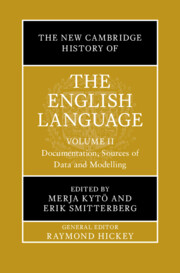Book contents
- The New Cambridge History of the English Language
- The New Cambridge History of the English Language
- The New Cambridge History of the English Language
- Copyright page
- Contents
- Figures
- Tables
- Contributors to Volume II
- General Preface
- Abbreviations for Corpora and Other Electronic Resources
- General Editor’s Introduction
- Introduction to Volume II
- Part I The Textual Record
- Part II Lighthouse Works and Authors
- Part III Genre and Medium in the Record
- Part IV Modelling the Record: Methods and Theories
- 27 Quantitative Methods and the History of English
- 28 Generative Accounts of Change
- 29 Functional Accounts of Change
- 30 Grammaticalisation
- 31 Cognitive Approaches to the History of English
- 32 Construction Grammar and English Historical Linguistics
- 33 Psycholinguistic Perspectives on Language Change
- Appendix: List of Corpora and Other Electronic Resources
- Index
- References
27 - Quantitative Methods and the History of English
from Part IV - Modelling the Record: Methods and Theories
Published online by Cambridge University Press: 18 October 2025
- The New Cambridge History of the English Language
- The New Cambridge History of the English Language
- The New Cambridge History of the English Language
- Copyright page
- Contents
- Figures
- Tables
- Contributors to Volume II
- General Preface
- Abbreviations for Corpora and Other Electronic Resources
- General Editor’s Introduction
- Introduction to Volume II
- Part I The Textual Record
- Part II Lighthouse Works and Authors
- Part III Genre and Medium in the Record
- Part IV Modelling the Record: Methods and Theories
- 27 Quantitative Methods and the History of English
- 28 Generative Accounts of Change
- 29 Functional Accounts of Change
- 30 Grammaticalisation
- 31 Cognitive Approaches to the History of English
- 32 Construction Grammar and English Historical Linguistics
- 33 Psycholinguistic Perspectives on Language Change
- Appendix: List of Corpora and Other Electronic Resources
- Index
- References
Summary
This chapter surveys the role of quantitative methods in diachronic studies which investigate the past and present stages of English. We begin with simple bivariate analyses, such as tracing frequency developments, discuss inferential models and explain the advantages of multifactorial (including hierarchical) modelling. Moreover, we trace changing productivity, association strengths, lexical biases and collocational preferences within constructions. We also discuss methods for exploratory analysis of multidimensional data and provide a brief overview of methods drawing from machine learning and other scientific disciplines (e.g. word embeddings and agent-based modeling). To illustrate our methodological points, we include small-scale hands-on analyses on the variation between will and be going to constructions as markers of future-time reference from the ARCHER and COHA corpora.
Information
- Type
- Chapter
- Information
- The New Cambridge History of the English LanguageDocumentation, Sources of Data and Modelling, pp. 665 - 693Publisher: Cambridge University PressPrint publication year: 2025
References
Accessibility standard: WCAG 2.0 A
Why this information is here
This section outlines the accessibility features of this content - including support for screen readers, full keyboard navigation and high-contrast display options. This may not be relevant for you.Accessibility Information
Content Navigation
Allows you to navigate directly to chapters, sections, or non‐text items through a linked table of contents, reducing the need for extensive scrolling.
Provides an interactive index, letting you go straight to where a term or subject appears in the text without manual searching.
Reading Order & Textual Equivalents
You will encounter all content (including footnotes, captions, etc.) in a clear, sequential flow, making it easier to follow with assistive tools like screen readers.
You get concise descriptions (for images, charts, or media clips), ensuring you do not miss crucial information when visual or audio elements are not accessible.
Visual Accessibility
You will still understand key ideas or prompts without relying solely on colour, which is especially helpful if you have colour vision deficiencies.
Structural and Technical Features
You gain clarity from ARIA (Accessible Rich Internet Applications) roles and attributes, as they help assistive technologies interpret how each part of the content functions.
